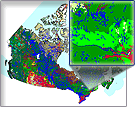Precipitation
Type of resources
Available actions
Topics
Keywords
Contact for the resource
Provided by
Years
Formats
Representation types
Update frequencies
status
Service types
-

The Drought Impact Lines dataset highlights areas that have been physically impacted by drought. All drought impact lines have a drought impact label inside of them to express the longevity of the impact. The impact lines are classified using impact labels as follows: S – Short-Term, typically less than 6 months. L – Long-Term, typically more than 6 months. SL – A combination of Short and Long-Term impacts.
-

The Drought Impact Label dataset is used on all drought polygons from D1 to D4 to specify the longitude and magnitude of impacts. Impact labels are often used in association with the Drought Impact Line dataset. The impact labels are classified as follows: S – Short-Term, typically less than 6 months. L – Long-Term, typically more than 6 months. SL – A combination of Short and Long-Term impacts.
-

This series of datasets has been created by AAFC’s National Agroclimate Information Service (NAIS) of the Agro-Climate, Geomatics and Earth Observations (ACGEO) Division of the Science and Technology Branch. The Canadian Drought Monitor (CDM) is a composite product developed from a wide assortment of information such as the Normalized Difference Vegetation Index (NDVI), streamflow values, Palmer Drought Index, and drought indicators used by the agriculture, forest and water management sectors. Drought prone regions are analyzed based on precipitation, temperature, drought model index maps, and climate data and are interpreted by federal, provincial and academic scientists. Once a consensus is reached, a monthly map showing drought designations for Canada is digitized. AAFC’s National Agroclimate Information Service (NAIS) updates this dataset on a monthly basis, usually by the 10th of every month to correspond to the end of the previous month, and subsequent Canadian input into the larger North American Drought Monitor (NA-DM). The drought areas are classified as follows: D0 (Abnormally Dry) – represents an event that occurs once every 3-5 years; D1 (Moderate Drought) – represents an event that occurs every 5-10 years; D2 (Severe Drought) – represents an event that occurs every 10-20 years; D3 (Extreme Drought) – represents an event that occurs every 20-25 years; and D4 (Exceptional Drought) – represents an event that occurs every 50 years. Impact lines highlight areas that have been physically impacted by drought. Impact labels specify the longitude and magnitude of impacts. The impact labels are classified as follows: S – Short-Term, typically less than 6 months (e.g. agriculture, grasslands). L – Long-Term, typically more than 6 months (e.g. hydrology, ecology).
-
This data represents the dryness of the land surface based on vegetation conditions. The data is created weekly and uses weekly information on precipitation anomalies (namely the Standardized Precipitation Index or SPI) and satellite vegetation condition derived from Normalized Difference Vegetation Index (NDVI) from the MODIS Satellite. These dynamic data sets along with static data sets on land cover, soil water holding capacity, irrigation, ecozones and land surface elevation are used to model the drought severity, based on the Palmer Drought Severity Index (PDSI). The mapcubist model was trained on historical data and applied in real time to the dynamic inputs to produce drought severity ratings. The model is run at a 1km resolution and was developed by the AAFC, the United States Geological Survey and the United States Drought Monitor at the University of Nebraska Lincoln.
-
30-year Average precipitation represents the average amount (mm) of precipitation received in a month across a 30 year period (1961-1991, 1971-2000, 1981-2010, 1991-2020). These values are calculated across Canada in 10x10 km cells.
-
First Fall Frost (0 °C) is defined as the average day, during the second half of the year, of the first occurrence of a minimum temperature at or below 0 °C. These values are calculated across Canada in 10x10 km cells.
-
The Versatile Soil Moisture Budget (VSMB) is a soil water budget model that is continuous and deterministic in nature and was developed by AAFC. It is based on the premise that the water available for plant growth is gained by precipitation or irrigation, and lost through evapotranspiration and runoff as well as lateral and deep drainage. The daily net loss or gain is added or subtracted from the water already present in the rooting zone. Water is withdrawn simultaneously, but at different rates, from different soil depths, depending on the potential evapotranspiration, the stage of crop development, the water release characteristics of each soil layer and the available water.
-
This product provides runoff data with each contour line corresponding to an average amount of annual runoff (in millimeters). Runoff data were derived from discharge values from hydrometric stations with natural flows. Not all years are included for every region of the country due to data quality and availability issues. Data cover the period 1971 to 2013 for the south and 1971 to 2004 for the north. These files were produced by Statistics Canada, Environment, Energy and Transportation Statistics Division, 2017, based on data from Environment and Climate Change Canada, 2015, Water Survey of Canada, Archived Hydrometric Data (HYDAT), www.ec.gc.ca/rhc- wsc/default.asp?lang=En&n=4EED50F1-1 (accessed December 3, 2015); Spence, C. and A. Burke, 2008, “Estimates of Canadian Arctic Archipelago runoff from observed hydrometric data,” Journal of Hydrology, Vol. 362, pp. 247–259. For more information about methods, results and limitations see Appendix D in Statistics Canada, 2017, “Freshwater in Canada,” Human Activity and the Environment, Catalogue no. 16-201-X. The purpose of the dataset is to present runoff values as derived from Statistics Canada's Water Yield Model on a national scale map of 1:32,000,000. This product is intended to be used for reference or mapping purposes. The product ends at the shoreline of Canada as defined by the drainage region boundaries supplied for drainage regions of Canada. It does not include the Arctic Islands.
-

A soil survey is an inventory of soils and their spatial distribution over a landscape. Soil survey reports contain two parts. The first part is a soil map or series of maps at a particular scale with coding for each soil. Soil survey reports also include a supporting document that contains background information such as how the soil survey was conducted, and an explanation of interpretive criteria and a summary of the area occupied by various soil types. The detailed soil surveys identify more of the variation in soil types across smaller landscapes, as compared to Generalized (1:100 000, i.e. provincial overview) and Reconnaissance or General (1:125 000, or 1/2 inch to 1 mile.) soil surveys. Detailed soil survey information is much more accurate and reliable for making decisions at the farm-level. Soil surveys have been published for most of the agricultural areas, and many surrounding areas, across Canada. Data from these surveys comprise the most detailed soil inventory information in the National Soil Database (NSDB). Version 3 was created by Agriculture and Agri-Food Canada in the 2010's by amalgamating version 2 data. It introduced some minor refinements to the version 2 data structure to provide closer alignment with the Soil Landscapes of Canada data structure.
-
Growing Season Frost Free Period (0 °C) is defined as the count of the number of days from the day after the last spring frost (0 °C) to the day before the first fall frost (0 °C). These values are calculated across Canada in 10x10 km cells.
 Arctic SDI catalogue
Arctic SDI catalogue